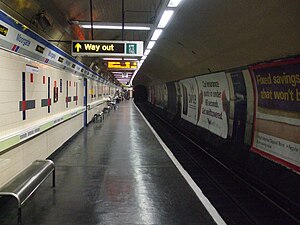Moorgate tube crash

Looking into the dead-end tunnel from platform 9 at Moorgate station
|
|
| Date | 28 February 1975 |
|---|---|
| Time | 08:46 GMT |
| Location | Moorgate |
| Country | England |
| Rail line | Northern Line (Highbury Branch) |
| Operator | London Underground |
| Cause | Driver failed to stop |
| Statistics | |
| Trains | 1 |
| Passengers | 300 |
| Deaths | 43 |
| Injuries | 74 |
| List of UK rail accidents by year | |
The Moorgate tube crash occurred on 28 February 1975 at 08:46 GMT on the Northern City Line, then operated by London Underground as the Highbury branch of the Northern line. A train failed to stop at the Moorgate station, the line's southern terminus, and crashed into the wall at the end of the tunnel. In the greatest loss of life during peacetime in the London Underground, 43 people died and a further 74 were injured. With no fault being found with the train equipment, a report from the Department of the Environment found that the driver had failed to slow the train and stop at the station and there was insufficient evidence to determine the reason.
Following the crash, a safety system that stops a train automatically if the driver fails to brake was introduced on the London Underground which became informally known as Moorgate protection.
On Friday, 28 February 1975, the 08:38 service from Drayton Park on the Northern line's Highbury branch left one minute late. Formed of two three-car units of , on arrival at the station, the train failed to slow, passing through the station at 30–40 mph (48–64 km/h), before entering the 66-foot (20 m) long overrun tunnel with a red stop-lamp, a sand drag and hydraulic buffer stop. The sand drag only slowed the train slightly, before the train collided heavily with the buffers and then the wall.
The Highbury branch tunnels were built to accommodate surface line loading gauge trains and were 16 feet (4.9 m) high. The smaller diameter of the tube train involved allowed the first car to ride up over the hydraulic buffers, with the second coach driving under the first, leading to significant damage at this end. The leading driving car buckled at three points into a V shape and was crushed to less than half its length between the wall and the weight of the train piling up behind it. The third car was damaged at both ends, more significantly at the leading end as it rode over the second car. Approximately 300 passengers were on the train: 42 passengers and the driver died and 74 passengers were treated in hospital for their injuries.
Emergency services were called at 08:48, the first ambulances arriving at 08:54 and the fire brigade at 08:58. The Post Office organised impromptu telephone lines in the station for the emergency services.
...
Wikipedia
